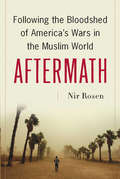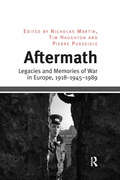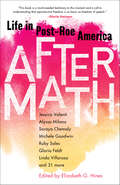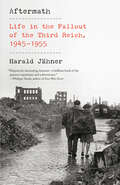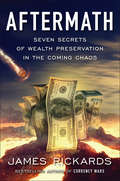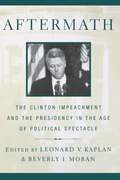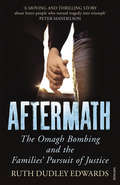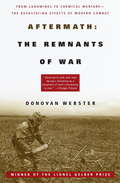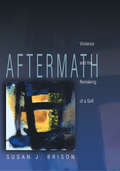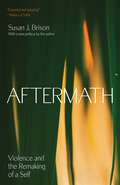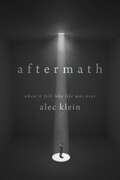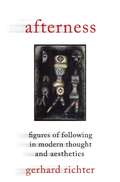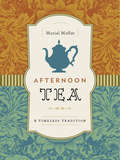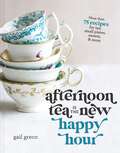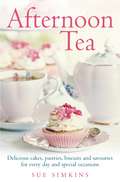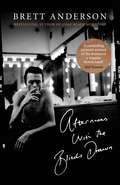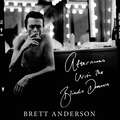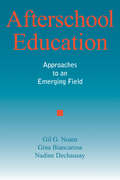- Table View
- List View
Aftermath: Following the Bloodshed of America's Wars in the Muslim World
by Nir RosenAs Iraq confronts a bleak and uncertain future and instability spreads throughout the region, an award winning journalist describes the new shape of the Middle East
Aftermath: Legacies and Memories of War in Europe, 1918–1945–1989
by Tim HaughtonFocusing on three of the defining moments of the twentieth century - the end of the two World Wars and the collapse of the Iron Curtain - this volume presents a rich collection of authoritative essays, covering a wide range of thematic, regional, temporal and methodological perspectives. By re-examining the traumatic legacies of the century’s three major conflicts, the volume illuminates a number of recurrent yet differentiated ideas concerning memorialisation, mythologisation, mobilisation, commemoration and confrontation, reconstruction and representation in the aftermath of conflict. The post-conflict relationship between the living and the dead, the contestation of memories and legacies of war in cultural and political discourses, and the significance of generations are key threads binding the collection together. While not claiming to be the definitive study of so vast a subject, the collection nevertheless presents a series of enlightening historical and cultural perspectives from leading scholars in the field, and it pushes back the boundaries of the burgeoning field of the study of legacies and memories of war. Bringing together historians, literary scholars, political scientists and cultural studies experts to discuss the legacies and memories of war in Europe (1918-1945-1989), the collection makes an important contribution to the ongoing interdisciplinary conversation regarding the interwoven legacies of twentieth-century Europe’s three major conflicts.
Aftermath: Life in Post-Roe America
by Elizabeth G. HinesAfter nearly fifty years as settled constitutional law, the federally protected right to an abortion in America is now a thing of the past. The Supreme Court’s overturning of Roe v. Wade has left Americans without a guaranteed right to access abortion―and the cost of that upheaval will be most painfully felt by individuals who already struggle with access to resources: the poor, Black and brown communities, and members of the LGBTQIA+ population. Pulling together the experiences, expertise, and perspectives of more than 30 writers, thinkers, and activists, Aftermath: Life in Post-Roe America offers a searing look at the critical role Roe has played in improving women’s and pregnant people’s lives, what a future without Roe may look like, and what options exist for us to secure reproductive freedom in the future. With contributions from Jessica Valenti, Soraya Chemaly, Michele Goodwin, Alyssa Milano, Ruby Sales, Heather Cox Richardson, Robin Marty, Linda Villarosa, Jennifer Baumgardner and more, this anthology is essential reading for anyone who cares about the future of reproductive rights in America―and beyond.
Aftermath: Life in the Fallout of the Third Reich, 1945-1955
by Harald JähnerHow does a nation recover from fascism and turn toward a free society once more? This internationally acclaimed revelatory history—"filled with first-person accounts from articles and diaries" (The New York Times)—of the transformational decade that followed World War II illustrates how Germany raised itself out of the ashes of defeat and reckoned with the corruption of its soul and the horrors of the Holocaust. Featuring over 40 eye-opening black-and-white photographs and posters from the period. The years 1945 to 1955 were a raw, wild decade that found many Germans politically, economically, and morally bankrupt. Victorious Allied forces occupied the four zones that make up present-day Germany. More than half the population was displaced; 10 million newly released forced laborers and several million prisoners of war returned to an uncertain existence. Cities lay in ruins—no mail, no trains, no traffic—with bodies yet to be found beneath the towering rubble. Aftermath received wide acclaim and spent forty-eight weeks on the best-seller list in Germany when it was published there in 2019. It is the first history of Germany's national mentality in the immediate postwar years. Using major global political developments as a backdrop, Harald Jähner weaves a series of life stories into a nuanced panorama of a nation undergoing monumental change. Poised between two eras, this decade is portrayed by Jähner as a period that proved decisive for Germany's future—and one starkly different from how most of us imagine it today.
Aftermath: Readings in the Archaeology of Recent Conflict
by John SchofieldConflict and Battlefield Archaeology is a growing and important field in archaeology, with implications on the state of the world today: how humanity has prepared for, reacted to, and dealt with the consequences of conflict at a national and international level. As the field grows, there is an increasing need for research and development in this area. Written by one of the most prominent scholars in this field of growing interest, "Aftermath", offers a clear and important overview to research in the field. It will become an essential source of information for scholars already involved in conflict archaeology as well as those just starting to explore the field. It offers access to previously hard-to-find but important research.
Aftermath: Seven Secrets of Wealth Preservation in the Coming Chaos
by James RickardsIn his most prescriptive book to date, financial expert and investment advisor James Rickards shows how and why our financial markets are being artificially inflated--and what smart investors can do to protect their assetsWhat goes up, must come down. As any student of financial history knows, the dizzying heights of the stock market can't continue indefinitely--especially since asset prices have been artificially inflated by investor optimism around the Trump administration, ruinously low interest rates, and the infiltration of behavioral economics into our financial lives. The elites are prepared, but what's the average investor to do? James Rickards, the author of the prescient books Currency Wars, The Death of Money, and The Road to Ruin, lays out the true risks to our financial system, and offers invaluable advice on how best to weather the storm. You'll learn, for instance: * How behavioral economists prop up the market: Funds that administer 401(k)s use all kinds of tricks to make you invest more, inflating asset prices to unsustainable levels. * Why digital currencies like Bitcoin and Ethereum are best avoided. * Why passive investing has been overhyped: The average investor has been scolded into passively managed index funds. But active investors will soon have a big advantage. * What the financial landscape will look like after the next crisis: it will not be an apocalypse, but it will be radically different. Those who forsee this landscape can prepare now to preserve wealth.Provocative, stirring, and full of counterintuitive advice, Aftermath is the book every smart investor will want to get their hands on--as soon as possible.
Aftermath: The Clinton Impeachment and the Presidency in the Age of Political Spectacle (Critical America #7)
by Leonard V. KaplanWith the specter of prosecution after his term is over and the possibility of disbarment in Arkansas hanging over President Clinton, the Clinton-Lewinsky scandal and the events that have followed it show no sign of abating. The question has become what to do, and how to think, about those eight months. Did the President lie or was it plausible that he had truthfully testified to no sexual relationship? Was the job search for Monica just help for a friend or a sinister means of obtaining silence? Even if all the charges were true, did impeachment follow or was censure enough? And what are the lasting repercussions on the office of the Presidency? Aftermath: The Clinton Impeachment and the Presidency in the Age of Political Spectacle takes a multi-disciplinary approach to analyze the Clinton impeachment from political perspectives across the spectrum. The authors attempt to tease out the meanings of the scandal from the vantage point of law, religion, public opinion, and politics, both public and personal. Further, the impeachment itself is situated broadly within the contemporary American liberal state and mined for the contradictory possibilities for reconciliation it reveals in our culture. Contributors: David T. Canon, John Cooper, Drucilla Cornell, Jean Bethke Elshtain, Robert W. Gordon, Lawrence Joseph, Leonard V. Kaplan, David Kennedy, Kenneth R. Mayer, Beverly I. Moran, Father Richard John Neuhaus, David Novak, Linda Denise Oakley, Elizabeth Rapaport, Lawrence Rosen, Eric Rothstein, Aviam Soifer, Lawrence M. Solan, Cass R. Sunstein, Stephen Toulmin, Leon Trakman, Frank Tuerkheimer, Mark V. Tushnet, Andrew D. Weiner, Robin L. West.
Aftermath: The Omagh Bombing and the Families' Pursuit of Justice
by Ruth Dudley EdwardsOn Saturday 15th August, 1998, a massive bomb placed by the so-called Real IRA ripped through the town of Omagh, killing twenty-nine people, including eleven children, and injuring over two hundred. It was the worst massacre in Northern Ireland's modern history- yet from it came a most extraordinary tale of human resilience, as the families of ten of the dead channelled their grief into action.Taking for their motto, 'For evil to triumph, all that is necessary is for good men to do nothing', they decided to pursue the men whom the police believed responsible for the atrocity through the civil courts, where the burden of proof is lower. This is the remarkable account of how these families- who had no knowledge of the law and no money- became internationally recognised, formiddable campaigners and surmounted countless daunting obstacles to win a famous victory.Longlisted for the Orwell Prize 2010
Aftermath: The Remnants of War
by Donovan WebsterIn riveting and revelatory detail, Aftermath documents the ways in which wars have transformed the terrain of the battlefield into landscapes of memory and enduring terror: in France, where millions of acres of farmland are cordoned off to all but a corps of demolition experts responsible for the undetonated bombs and mines of World War I that are now rising up in fields, gardens, and backyards; in a sixty-square-mile area outside Stalingrad that was a cauldron of destruction in 1941 and is today an endless field of bones; in the Nevada deserts, where America waged a hidden nuclear war against itself in the 1950's, the results of which are only now becoming apparent; in Vietnam, where a nation's effort to remove the physical detritus of war has created psychological and genetic devastation; in Kuwait, where terrifyingly sophisticated warfare was followed by the Sisyphean task of making an uninhabitable desert capable of sustaining life.Aftermath excavates our century's darkest history, revealing that the destruction of the past remains deeply, inextricably embedded in the present.
Aftermath: Violence and the Remaking of a Self
by Susan J. BrisonOn July 4, 1990, while on a morning walk in southern France, Susan Brison was attacked from behind, severely beaten, sexually assaulted, strangled to unconsciousness, and left for dead. She survived, but her world was destroyed. Her training as a philosopher could not help her make sense of things, and many of her fundamental assumptions about the nature of the self and the world it inhabits were shattered. At once a personal narrative of recovery and a philosophical exploration of trauma, this book examines the undoing and remaking of a self in the aftermath of violence. It explores, from an interdisciplinary perspective, memory and truth, identity and self, autonomy and community. It offers imaginative access to the experience of a rape survivor as well as a reflective critique of a society in which women routinely fear and suffer sexual violence. As Brison observes, trauma disrupts memory, severs past from present, and incapacitates the ability to envision a future. Yet the act of bearing witness, she argues, facilitates recovery by integrating the experience into the survivor's life's story. She also argues for the importance, as well as the hazards, of using first-person narratives in understanding not only trauma, but also larger philosophical questions about what we can know and how we should live. Bravely and beautifully written, Aftermath is that rare book that is an illustration of its own arguments.
Aftermath: Violence and the Remaking of a Self
by Susan J. BrisonA powerful personal narrative of recovery and an illuminating philosophical exploration of traumaOn July 4, 1990, while on a morning walk in southern France, Susan Brison was attacked from behind, severely beaten, sexually assaulted, strangled to unconsciousness, and left for dead. She survived, but her world was destroyed. Her training as a philosopher could not help her make sense of things, and many of her fundamental assumptions about the nature of the self and the world it inhabits were shattered.At once a personal narrative of recovery and a philosophical exploration of trauma, this bravely and beautifully written book examines the undoing and remaking of a self in the aftermath of violence. It explores, from an interdisciplinary perspective, memory and truth, identity and self, autonomy and community. It offers imaginative access to the experience of a rape survivor as well as a reflective critique of a society in which women routinely fear and suffer sexual violence.As Brison observes, trauma disrupts memory, severs past from present, and incapacitates the ability to envision a future. Yet the act of bearing witness, she argues, facilitates recovery by integrating the experience into the survivor's life's story. She also argues for the importance, as well as the hazards, of using first-person narratives in understanding not only trauma, but also larger philosophical questions about what we can know and how we should live.
Aftermath: When It Felt Like Life Was Over
by Alec KleinFor years, Alec Klein investigated cases where people faced the nightmare of wrongful accusations. Suddenly, he found himself on the other side, falsely accused himself.For years, Alec Klein investigated cases where people faced the nightmare of wrongful accusations. Suddenly, he found himself on the other side, falsely accused himself. In a coordinated media attack, he was accused of misconduct as a professor at a top U.S. university, and in a rush to judgment, before he had a chance to defend himself, his life was destroyed. What happens when you have little hope? In the aftermath, Alec gravitated to the unlikeliest of places, among the unlikeliest of people, doing the unlikeliest of things. This is a first-person true story about faith, forgiveness and redemption.
Afterness: Figures of Following in Modern Thought and Aesthetics (Columbia Themes in Philosophy, Social Criticism, and the Arts)
by Gerhard RichterGerhard Richter's groundbreaking study argues that the concept of "afterness" is a key figure in the thought and aesthetics of modernity. It pursues questions such as: What does it mean for something to "follow" something else? Does that which follows mark a clear break with what came before it, or does it in fact tacitly perpetuate its predecessor as a consequence of its inevitable indebtedness to the terms and conditions of that from which it claims to have departed? Indeed, is not the very act of breaking with, and then following upon, a way of retroactively constructing and fortifying that from which the break that set the movement of following into motion had occurred? <P><P>The book explores the concept and movement of afterness as a privileged yet uncanny category through close readings of writers such as Kant, Kafka, Heidegger, Bloch, Benjamin, Brecht, Adorno, Arendt, Lyotard, and Derrida. It shows how the vexed concepts of afterness, following, and coming after shed new light on a constellation of modern preoccupations, including personal and cultural memory, translation, photography, hope, and the historical and conceptual specificity of what has been termed "after Auschwitz." The study's various analyses-across a heterogeneous collection of modern writers and thinkers, diverse historical moments of articulation, and a range of media-conspire to illuminate Lyotard's apodictic statement that "after philosophy comes philosophy. But it has been altered by the 'after.'" As Richter's intricate study demonstrates, much hinges on our interpretation of the "after." After all, our most fundamental assumptions concerning modern aesthetic representation, conceptual discourse, community, subjectivity, and politics are at stake.
Afternoon Tea
by Muriel MoffatA delectable peek at the tradition of afternoon tea at the Fairmont Empress Hotel -- and the enchanting history of taking teaMuriel Moffat has been sipping tea at Victoria's storied Empress Hotel for 60 years -- and sharing all those lovely cups with four generations of Moffats. When she poured her love of all things tea into a darling little book, it soon became a bestseller, with 30,000 copies sold from the shelves of the Empress gift shop in just five years. Beautifully redesigned and ready for its book trade debut, Afternoon Tea offers a peek behind the curtain at the magnificent hotel, where afternoon tea has been taken with elegance and gourmet indulgence since 1908. Included are several well-loved recipes from the Tea Lobby, which has hosted the likes of Queen Elizabeth II, Rudyard Kipling and Shirley Temple.This charming book is also a chatty and colourful history of tea and the many rituals surrounding it, sure to entertain the novice and enthusiast alike. Steeped in a love of traditions, Ms. Moffat's beloved book celebrates a littleknown ritual that may just be the foundation of everything worthy -- family, friends and, of course, tea.
Afternoon Tea
by OctopusAfternoon Tea is every woman's dream book, as delightful to look at as it is to cook from. Think finger sandwiches, scones, pastries, cakes, biscuits and slices. Think linen tablecloths and fine china, proper tea made in a teapot, a group of your best friends gathered round, and lots of gossip. Here's your chance to spoil yourself with cucumber sandwiches, chocolate éclairs and raspberry cream sponge. Teatime will never be the same again.
Afternoon Tea Is the New Happy Hour: More than 75 Recipes for Tea, Small Plates, Sweets and More
by Gail GrecoAfternoon tea is more than a meal--it's a moment, an aesthetic, a pose. Afternoon Tea Is the New Happy Hour features more than 75 recipes to make your tea time memorable.Inside you'll find easy-to-follow recipes to create tea sandwiches, scones, breads, cakes, dips, and, of course--tea. Whether you're throwing a vintage tea party or looking for high tea food ideas, there's something for everyone.Bestselling author Gail Greco also shares cooking and serving tea tips, tea etiquette, insight on the differences between using tea bags, a tea kettle, and loose leaves, and the lingo used by tea connoisseurs. Gail includes her own food photography which showcases the happy hour crowd pleasers.In this cookbook, you'll find:Plenty of tea time favorites, like Apple Hibiscus Tea, Tea Toddy One-Shot, Alice's Sorbet Float Tea, and Basic Barista Tea Latte with Rooibos.For appetizers Gail shares Cheddar Ranch Crab Dip, Spicey Baked Artichoke Bruschetta, Pizza Cupcakes, and Mini Soft Baked Pretzels.If you're craving sandwiches, you'll find Pimento Pita Pocket Poufs and Food Truck Zone Shrimp/Corn ' Wiches.And to keep everyone excited, you'll find Tea-Thyme Ginger Bars, Glazed Lemon Loaf Cake, Teasicles, Potato Chip Walnut Tartlets, and Puddle-of-Chocolate and Chai Pots de Crème.There's something for everyone!This beautiful cookbook will provide you with the high tea food ideas you can't find anywhere else. Afternoon Tea Is the New Happy Hour is a wildly creative mix of vintage and modern. Pinkies up, it's tea time!
Afternoon Tea: Delicious cakes, pastries, biscuits and savouries for every day and special occasions
by Sue SimkinsThis book contains a fascinating collection of delicious recipes for every kind of tea you could imagine, whether it is simple tea and biscuits, traditional afternoon tea, or a more substantial high tea for the children. You?ll also find lots of ideas for special occasion teas such as children?s parties and christenings. It includesSandwiches and savouries Cakes, buns and sconesPastries and biscuits There is also an overview of all the different kinds of tea available to drink plus lemonade recipes for summer tea in the garden.
Afternoon Tea: Delicious cakes, pastries, biscuits and savouries for every day and special occasions
by Sue SimkinsThis book contains a fascinating collection of delicious recipes for every kind of tea you could imagine, whether it is simple tea and biscuits, traditional afternoon tea, or a more substantial high tea for the children. You’ll also find lots of ideas for special occasion teas such as children’s parties and christenings. It includesSandwiches and savouries Cakes, buns and sconesPastries and biscuits There is also an overview of all the different kinds of tea available to drink plus lemonade recipes for summer tea in the garden.
Afternoons with Mr. Hogan
by Jody VasquezBen Hogan's former ball shagger recounts firsthand stories of the golf legend—andreveals, for the first time, Hogan's Swing Secret, a source of mystery to golfers for more than fifty years. Ben Hogan's pro golf record is legendary. A four-time PGA Player of the Year, he celebrated sixty-three tournament wins and became known as a man of few words and fewer close friends. Most of what we know about Hogan has been based on myth and speculation. Until now. In the 1960s, though Hogan's competitive career was over, he kept the practice habits that made him famous and remade modern competitive golf. He hired seventeen-year-old Jody Vasquez to help. Each day, after driving to a remote part of the course at Shady Oaks Country Club, Hogan would spend hours hitting balls and Vasquez would retrieve them. There, and over the course of their twenty-year friendship, Hogan taught Jody the mechanics of his famous swing and shared his thoughts on playing, practicing, and course management—unknowingly revealing much about his character, values, and beliefs, and the events that shaped them. In Afternoons with Mr. Hogan, Jody Vasquez shares dozens of stories about Hogan, from the way he practiced, selected his clubs, and interacted with other star players to his little-known humor and generosity. Combining the gentle insight of Tom Kite's A Fairway to Heaven (which recalls Kite's golf education under Harvey Penick) with the sage perspective of Penick's own Little Red Book, Vasquez's tribute is funny, poignant, and full of advice for golfers of all levels. .
Afternoons with the Blinds Drawn
by Brett Anderson'A compelling personal account of the dramas of a singular British band' Neil TennantThe trajectory of Suede - hailed in infancy as both 'The Best New Band in Britain' and 'effete southern wankers' - is recalled with moving candour by its frontman Brett Anderson, whose vivid memoir swings seamlessly between the tender, witty, turbulent, euphoric and bittersweet. Suede began by treading the familiar jobbing route of London's emerging new 1990s indie bands - gigs at ULU, the Camden Powerhaus and the Old Trout in Windsor - and the dispiriting experience of playing a set to an audience of one. But in these halcyon days, their potential was undeniable. Anderson's creative partnership with guitarist Bernard Butler exposed a unique and brilliant hybrid of lyric and sound; together they were a luminescent team - burning brightly and creating some of the era's most revered songs and albums.In Afternoons with the Blinds drawn, Anderson unflinchingly explores his relationship with addiction, heartfelt in the regret that early musical bonds were severed, and clear-eyed on his youthful persona. 'As a young man . . . I oscillated between morbid self-reflection and vainglorious narcissism' he writes. His honesty, sharply self-aware and articulate, makes this a compelling autobiography, and a brilliant insight into one of the most significant bands of the last quarter century.
Afternoons with the Blinds Drawn
by Brett Anderson'A compelling personal account of the dramas of a singular British band' Neil TennantThe trajectory of Suede - hailed in infancy as both 'The Best New Band in Britain' and 'effete southern wankers' - is recalled with moving candour by its frontman Brett Anderson, whose vivid memoir swings seamlessly between the tender, witty, turbulent, euphoric and bittersweet. Suede began by treading the familiar jobbing route of London's emerging new 1990s indie bands - gigs at ULU, the Camden Powerhaus and the Old Trout in Windsor - and the dispiriting experience of playing a set to an audience of one. But in these halcyon days, their potential was undeniable. Anderson's creative partnership with guitarist Bernard Butler exposed a unique and brilliant hybrid of lyric and sound; together they were a luminescent team - burning brightly and creating some of the era's most revered songs and albums.In Afternoons with the Blinds drawn, Anderson unflinchingly explores his relationship with addiction, heartfelt in the regret that early musical bonds were severed, and clear-eyed on his youthful persona. 'As a young man . . . I oscillated between morbid self-reflection and vainglorious narcissism' he writes. His honesty, sharply self-aware and articulate, makes this a compelling autobiography, and a brilliant insight into one of the most significant bands of the last quarter century.
Afternoons with the Blinds Drawn
by Brett Anderson'A compelling personal account of the dramas of a singular British band' Neil TennantThe trajectory of Suede - hailed in infancy as both 'The Best New Band in Britain' and 'effete southern wankers' - is recalled with moving candour by its frontman Brett Anderson, whose vivid memoir swings seamlessly between the tender, witty, turbulent, euphoric and bittersweet. Suede began by treading the familiar jobbing route of London's emerging new 1990s indie bands - gigs at ULU, the Powerhaus and the Old Trout in Windsor - and the dispiriting experience of playing a set to an audience of one. But in these halcyon days, their potential was undeniable. Anderson's creative partnership with guitarist Bernard Butler exposed a unique and brilliant hybrid of lyric and sound; together they were a luminescent team - burning brightly and creating some of the era's most revered songs and albums.In Afternoons with the Blinds drawn, Anderson unflinchingly explores his relationship with addiction, heartfelt in the regret that early musical bonds were severed, and clear-eyed on his youthful persona. 'As a young man . . . I oscillated between morbid self-reflection and vainglorious narcissism' he writes. His honesty, sharply self-aware and articulate, makes this a compelling autobiography, and a brilliant insight into one of the most significant bands of the last quarter century.
Afterschool Education: Approaches to an Emerging Field
by Gil G. Noam Gina Biancarosa Nadine DechausayThe authors survey the current afterschool landscape and bring to light important issues and practices within the field, explore the challenges and opportunities facing afterschool education programs, and point to future directions for these burgeoning educational ventures. Afterschool education has grown in recent years into a vast and diverse enterprise. In the United States, young people spend almost a third of their organized time (including school hours) in afterschool and summer programs. Yet there is little clear and conclusive research on afterschool programs—research that would help guide the practice of existing afterschool programs and establish guidelines for the creation of new programs. An indispensable guide for practitioners, administrators, policy makers, and parents, Afterschool Education will serve as the cornerstone for all future accounts of and proposals for this crucial educational field.
Afterschool Education: Approaches to an Emerging Field
by Gil G. Noam Gina Biancarosa Nadine DechausayThe authors survey the current afterschool landscape and bring to light important issues and practices within the field, explore the challenges and opportunities facing afterschool education programs, and point to future directions for these burgeoning educational ventures. Afterschool education has grown in recent years into a vast and diverse enterprise. In the United States, young people spend almost a third of their organized time (including school hours) in afterschool and summer programs. Yet there is little clear and conclusive research on afterschool programs—research that would help guide the practice of existing afterschool programs and establish guidelines for the creation of new programs. An indispensable guide for practitioners, administrators, policy makers, and parents, Afterschool Education will serve as the cornerstone for all future accounts of and proposals for this crucial educational field.
